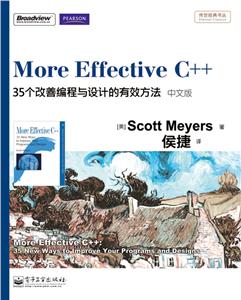掃一掃
關注中圖網
官方微博
本類五星書更多>
-
>
全國計算機等級考試最新真考題庫模擬考場及詳解·二級MSOffice高級應用
-
>
決戰行測5000題(言語理解與表達)
-
>
軟件性能測試.分析與調優實踐之路
-
>
第一行代碼Android
-
>
JAVA持續交付
-
>
EXCEL最強教科書(完全版)(全彩印刷)
-
>
深度學習
傳世經典書叢More Effective C++:35個改善編程與設計的有效方法(中文版) 版權信息
- ISBN:9787121125706
- 條形碼:9787121125706 ; 978-7-121-12570-6
- 裝幀:一般膠版紙
- 冊數:暫無
- 重量:暫無
- 所屬分類:>>
傳世經典書叢More Effective C++:35個改善編程與設計的有效方法(中文版) 內容簡介
繼Effective C++之后,Scott Meyers于1996推出這本“續集”。條款變得比較少,頁數倒是多了一些,原因是這次選材比“集”更高階,尤其是第5章。Meyers將此章命名為技術(techniques),并明白告訴你,其中都是一些patterns,例如virtual constructors,smart pointers,reference counting,proxy classes,double dispatching……這一章的每個條款篇幅都達15~30 頁之多,實在讓人有“山重水復疑無路,柳暗花明又一村”之嘆。 雖然出版年代稍嫌久遠,但本書并沒有第2版,原因是當其出版之時(1996),C++ Standard已經幾乎定案,本書即依當時的標準草案而寫,其與現今的C++ 標準規范幾乎相同。而且可能變化的幾個彈性之處,Meyers也都有所說明與提示。讀者可以登錄作者提供的網址,看看上下兩集的勘誤與討論(數量之多,令人驚恐。幸好多是技術討論或文字斟酌,并沒有什么重大誤失)。
傳世經典書叢More Effective C++:35個改善編程與設計的有效方法(中文版) 目錄
目 錄
譯序(侯捷) ix
導讀(Introduction) 001
基礎議題(Basics) 009
條款1:仔細區別 pointers 和 references 009
Distinguish between pointers and references.
條款2:*好使用 C++ 轉型操作符 012
Prefer C++-style casts.
條款3:絕對不要以多態(polymorphically)方式處理數組 016
Never treat arrays polymorphically.
條款4:非必要不提供 default constructor 019
Avoid gratuitous default constructors.
操作符(Operators) 024
條款5:對定制的“類型轉換函數”保持警覺 024
Be wary of user-defined conversion functions.
條款6:區別 increment/decrement 操作符的
前置(prefix)和后置(postfix)形式 031
Distinguish between prefix and postfix forms of increment
and decrement operators.
條款7:千萬不要重載&&,||和, 操作符 035
Never overload &&, ||, or ,.
條款8:了解各種不同意義的 new 和 delete 038
Understand the different meanings of new and delete
異常(Exceptions) 044
條款9:利用 destructors 避免泄漏資源 045
Use destructors to prevent resource leaks.
條款10:在 constructors 內阻止資源泄漏(resource leak) 050
Prevent resource leaks in constructors.
條款11:禁止異常(exceptions)流出 destructors 之外 058
Prevent exceptions from leaving destructors.
條款12:了解“拋出一個 exception”與“傳遞一個參數”
或“調用一個虛函數”之間的差異 061
Understand how throwing an exception differs from
passing a parameter or calling a virtual function.
條款13:以 by reference 方式捕捉 exceptions 068
Catch exceptions by reference.
條款14:明智運用 exception specifications 072
Use exception specifications judiciously.
條款15:了解異常處理(exception handling)的成本 078
Understand the costs of exception handling.
效率(Efficiency) 081
條款16:謹記 80-20 法則 082
Remember the 80-20 rule.
條款17:考慮使用 lazy evaluation(緩式評估) 085
Consider using lazy evaluation.
條款18:分期攤還預期的計算成本 093
Amortize the cost of expected computations.
條款19:了解臨時對象的來源 098
Understand the origin of temporary objects.
條款20:協助完成“返回值優化(RVO)” 101
Facilitate the return value optimization.
條款21:利用重載技術(overload)避免隱式類型轉換(implict type conversions)105
Overload to avoid implicit type conversions.
條款22:考慮以操作符復合形式(op=)取代其獨身形式(op) 107
Consider using op= instead of stand-alone op.
條款23:考慮使用其他程序庫 110
Consider alternative libraries.
條款24:了解 virtual functions、multiple inheritance、virtual base classes、
runtime type identification 的成本 113
Understand the costs of virtual functions, multiple inheritance,
virtual base classes, and RTTI.
技術(Techniques, Idioms, Patterns) 123
條款25:將 constructor 和 non-member functions 虛化 123
Virtualizing constructors and non-member functions.
條款26:限制某個 class 所能產生的對象數量 130
Limiting the number of objects of a class.
條款27:要求(或禁止)對象產生于 heap 之中 145
Requiring or prohibiting heap-based objects.
條款28:Smart Pointers(智能指針) 159
條款29:Reference counting(引用計數) 183
條款30:Proxy classes(替身類、代理類) 213
條款31:讓函數根據一個以上的對象類型來決定如何虛化 228
Making functions virtual with respect to more than one object.
雜項討論(Miscellany) 252
條款32:在未來時態下發展程序 252
Program in the future tense.
條款33:將非尾端類(non-leaf classes)設計為
抽象類(abstract classes) 258
Make non-leaf classes abstract.
條款34:如何在同一個程序中結合 C++ 和 C 270
Understand how to combine C++ and C in the same program.
條款35:讓自己習慣于標準 C++ 語言 277
Familiarize yourself with the language standard.
推薦讀物 285
auto_ptr 實現代碼 291
索引(一)(General Index) 295
索引(二)(Index of Example Classes,Functions,and Templtes) 313
譯序(侯捷) ix
導讀(Introduction) 001
基礎議題(Basics) 009
條款1:仔細區別 pointers 和 references 009
Distinguish between pointers and references.
條款2:*好使用 C++ 轉型操作符 012
Prefer C++-style casts.
條款3:絕對不要以多態(polymorphically)方式處理數組 016
Never treat arrays polymorphically.
條款4:非必要不提供 default constructor 019
Avoid gratuitous default constructors.
操作符(Operators) 024
條款5:對定制的“類型轉換函數”保持警覺 024
Be wary of user-defined conversion functions.
條款6:區別 increment/decrement 操作符的
前置(prefix)和后置(postfix)形式 031
Distinguish between prefix and postfix forms of increment
and decrement operators.
條款7:千萬不要重載&&,||和, 操作符 035
Never overload &&, ||, or ,.
條款8:了解各種不同意義的 new 和 delete 038
Understand the different meanings of new and delete
異常(Exceptions) 044
條款9:利用 destructors 避免泄漏資源 045
Use destructors to prevent resource leaks.
條款10:在 constructors 內阻止資源泄漏(resource leak) 050
Prevent resource leaks in constructors.
條款11:禁止異常(exceptions)流出 destructors 之外 058
Prevent exceptions from leaving destructors.
條款12:了解“拋出一個 exception”與“傳遞一個參數”
或“調用一個虛函數”之間的差異 061
Understand how throwing an exception differs from
passing a parameter or calling a virtual function.
條款13:以 by reference 方式捕捉 exceptions 068
Catch exceptions by reference.
條款14:明智運用 exception specifications 072
Use exception specifications judiciously.
條款15:了解異常處理(exception handling)的成本 078
Understand the costs of exception handling.
效率(Efficiency) 081
條款16:謹記 80-20 法則 082
Remember the 80-20 rule.
條款17:考慮使用 lazy evaluation(緩式評估) 085
Consider using lazy evaluation.
條款18:分期攤還預期的計算成本 093
Amortize the cost of expected computations.
條款19:了解臨時對象的來源 098
Understand the origin of temporary objects.
條款20:協助完成“返回值優化(RVO)” 101
Facilitate the return value optimization.
條款21:利用重載技術(overload)避免隱式類型轉換(implict type conversions)105
Overload to avoid implicit type conversions.
條款22:考慮以操作符復合形式(op=)取代其獨身形式(op) 107
Consider using op= instead of stand-alone op.
條款23:考慮使用其他程序庫 110
Consider alternative libraries.
條款24:了解 virtual functions、multiple inheritance、virtual base classes、
runtime type identification 的成本 113
Understand the costs of virtual functions, multiple inheritance,
virtual base classes, and RTTI.
技術(Techniques, Idioms, Patterns) 123
條款25:將 constructor 和 non-member functions 虛化 123
Virtualizing constructors and non-member functions.
條款26:限制某個 class 所能產生的對象數量 130
Limiting the number of objects of a class.
條款27:要求(或禁止)對象產生于 heap 之中 145
Requiring or prohibiting heap-based objects.
條款28:Smart Pointers(智能指針) 159
條款29:Reference counting(引用計數) 183
條款30:Proxy classes(替身類、代理類) 213
條款31:讓函數根據一個以上的對象類型來決定如何虛化 228
Making functions virtual with respect to more than one object.
雜項討論(Miscellany) 252
條款32:在未來時態下發展程序 252
Program in the future tense.
條款33:將非尾端類(non-leaf classes)設計為
抽象類(abstract classes) 258
Make non-leaf classes abstract.
條款34:如何在同一個程序中結合 C++ 和 C 270
Understand how to combine C++ and C in the same program.
條款35:讓自己習慣于標準 C++ 語言 277
Familiarize yourself with the language standard.
推薦讀物 285
auto_ptr 實現代碼 291
索引(一)(General Index) 295
索引(二)(Index of Example Classes,Functions,and Templtes) 313
展開全部
書友推薦
- >
詩經-先民的歌唱
- >
中國人在烏蘇里邊疆區:歷史與人類學概述
- >
有舍有得是人生
- >
自卑與超越
- >
名家帶你讀魯迅:朝花夕拾
- >
我與地壇
- >
月亮虎
- >
月亮與六便士
本類暢銷

















